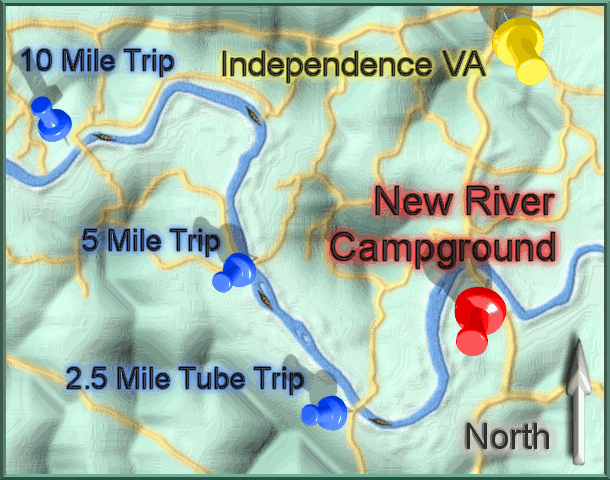
River Trips

Why tube and boat with us? New River Campground and Canoe, Inc. is on the whole New River! Other canoe and tubing vendors in the area are located either on the North Fork of the New or the South Fork, meaning that you are only on one-half of the New River. We are located after the two forks converge, thus creating the New River. We have double the amount of water, providing a better floating experience - especially as the warmer weather lowers the water levels.
We are now offering all of our River Trips 7 days a week. All of our New River trips originate from New River Campground Canoeing and Kayaking. We provide shuttle service to the put in point. All of our trips end at New River Campground, so there is no long shuttle back to your waiting campsite or vehicle after a day on the river. We highly suggest you reserve online or call ahead to make reservations to be sure we will have enough boats, tubes and shuttles to accommodate your group.
For those bringing their own canoes and kayaks, we also offer drop off and pick-up shuttle service if we have cargo space available. Please contact us in advance so we can accommodate your needs. For tube trips, we are only able to offer shuttle services for New River Campground river tube rentals due to limited cargo space and quality control to ensure your safety on the river.
We recommend large groups complete waivers ahead of your visit to expedite your check in. We accept cash and all major credit cards.
All of us here at New River Campground do everything possible to ensure a safe and fun trip for you. However, we assume no responsibility for your safety, or for the loss of or damage to your belongings, or for the loss of or damage to our equipment. You will be required to sign a renters agreement and liability release. It is highly recommended that everyone wear their life jackets at all times while enjoying the New River.
2.5 MILE TRIP
Perfect for fishing or tubing. On average one to one and a half hours of paddling time at normal water levels, not including any stopping time you would like to take to swim, fish, or picnic, etc.
10 MILE TRIP
601 to the campground. Contains Class I, Class II and one Class III rapids. The best section on the New River in this area for white water rapids. On average four to four and a half hours of paddling time at normal water levels, not including any stopping time you would like to take to swim, fish, or picnic, etc.

5 MILE TRIP
706 to the campground. Contains Class I and Class II rapids. On average 2.5 to 3 hours of paddling time at normal water levels, not including any stopping time you would like to take to swim, fish, or picnic, etc.












RAPID CLASS DEFINITIONS
The New River begins its journey in the north west mountains of North Carolina with the north and south forks. The two forks merge and the river flows on, north through Virginia then into West Virginia, where the New River finally empties into the Kanawha River. The water that starts flowing in North Carolina then makes its way to the mighty Mississippi, and eventually ends up in the Gulf of Mexico.
You will find Class I up to Class VI rapids through the entire course of the New River until it empties into the Kanawha. The section of the New River that we service contains Class I through Class III rapids under normal water conditions.

OUR SECTION OF THE NEW RIVER
It is highly recommended that everyone wear their life jackets at all times while on the New River.
-
Class I Rapids: Very easy. Small, regular waves. Passages clear, sandbanks, artificial difficulties like bridge piers, moving water with a few riffles.
-
Class II Rapids: Easy. Rapids with waves up to three (3) feet, with clear wide passages that are obvious without scouting. Low ledges. Some maneuvering is required.
-
Class III Rapids: Medium. Waves are numerous, high and irregular and can be capable of swamping an open canoe. Rocks, eddies. Rapids with passages that are clear, but narrow, requiring some expertise in maneuvering. May require scouting from shore.
AFTER HEAVY RAINS
Under very heavy rain conditions our Class III rapid can approach a Class IV in difficulty. Only for those that like it more extreme who have experience with rapids of that difficulty.
-
Class IV Rapids: Hard. Long difficult rapids with passages that are constricted which require precise manuevering in very turbulent waters. Scouting from shore is necessary. These conditions tend to make any rescue difficult with it generally being impossible for an open canoe. Sportsman in covered canoes or kayaks should have the ability to Eskimo roll.
OTHER RAPID CLASSES
Even though you will not encounter them on our stretch of the New River, we have included the other classes you can find on the New River for comparative purposes.
-
Class V Rapids: Very Hard. Extremely difficult, long, and very violent rapids with highly congested routes, that must always be scouted from shore. Rescue conditions are extremely difficult posing a significant risk to life should there be a mishap or attempted rescue, and not just for you but also for those attempting the rescue. The ability to Eskimo roll is a must for expert sportsman in decked canoes or kayaks.
-
Class VI Rapids: Extremely Dangerous. All the difficulties of Class V are taken to the extremes of navigability in this class designation. They are nearly impassible and incredibly dangerous. Only for teams of highly experienced experts, and then only after very intense study of the rapids has been conducted and every possible safety precaution has been taken.




